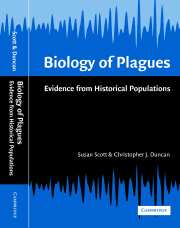Book contents
- Frontmatter
- Contents
- Preface
- Conversion table for imperial to metric units
- 1 Introduction
- 2 Epidemiological concepts
- 3 The biology of bubonic plague
- 4 The Great Pestilence
- 5 Case study: the plague at Penrith in 1597–98
- 6 Pestilence and plague in the 16th century in England
- 7 Plagues in the 16th century in northern England: a metapopulation study
- 8 Plagues in London in the 17th century
- 9 Plagues in the provinces in the 17th century
- 10 Plague at Eyam in 1665–66: a case study
- 11 Continental Europe during the third age of plagues: a study of large-scale metapopulation dynamics
- 12 The plague at Marseilles, 1720–22: an outbreak of bubonic plague?
- 13 Conclusions
- References
- Index
5 - Case study: the plague at Penrith in 1597–98
Published online by Cambridge University Press: 28 October 2009
- Frontmatter
- Contents
- Preface
- Conversion table for imperial to metric units
- 1 Introduction
- 2 Epidemiological concepts
- 3 The biology of bubonic plague
- 4 The Great Pestilence
- 5 Case study: the plague at Penrith in 1597–98
- 6 Pestilence and plague in the 16th century in England
- 7 Plagues in the 16th century in northern England: a metapopulation study
- 8 Plagues in London in the 17th century
- 9 Plagues in the provinces in the 17th century
- 10 Plague at Eyam in 1665–66: a case study
- 11 Continental Europe during the third age of plagues: a study of large-scale metapopulation dynamics
- 12 The plague at Marseilles, 1720–22: an outbreak of bubonic plague?
- 13 Conclusions
- References
- Index
Summary
Plague epidemics became steadily more widespread, with a greater death toll during the 16th century, as we describe in Chapter 6. The practice of keeping parish registers began during the last 50 years of this period and, together with other documentary sources, they have proved to be invaluable in determining the epidemiological characteristics of the plague. In this chapter, we present a case study of the plague at Penrith in 1597–98, which has previously been assumed to be a major outbreak of bubonic plague (Howson, 1961; Shrewsbury, 1970; Appleby, 1973). We describe the pattern of events there and the ways in which the individuals responded to this terrible visitation of the pestilence. Equally important, as we shall show, this detailed inspection of the data enables us to suggest the epidemiological characteristics of the disease. Armed with this information, we can then interpret the movement of the plague through the metapopulation of England in the 16th and 17th centuries in subsequent chapters, as it spread from population to population.
Penrith was a market town in the Eden Valley in Cumberland in northwest England and, it is said, the population had suffered from an earlier outbreak of plague in 1554. The registers began in 1557 and we have carried out a full family reconstitution from this date until 1812 (Scott & Duncan, 1998); we draw on the data derived therefrom in the following reconstruction of events during 1597–98.
- Type
- Chapter
- Information
- Biology of PlaguesEvidence from Historical Populations, pp. 115 - 148Publisher: Cambridge University PressPrint publication year: 2001

